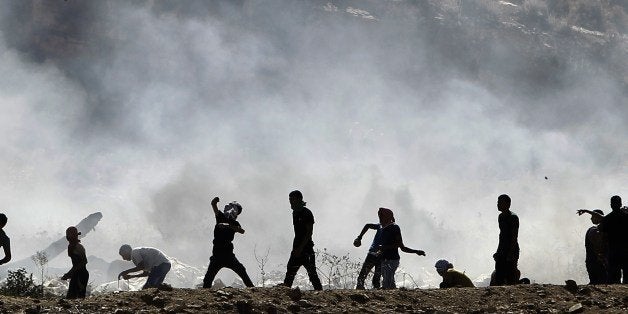
If a picture is worth a thousand words, then a video is worth a million. Nothing has as much impact as the moving image. It stirs our passions, our outrage... the film and television business has been well aware of this phenomenon from even the earliest days of Edison's invention. The right images put together can tell a very good story.
Bonnie and Clyde is a good filmic example of how to create sympathy for unlikely sympathetic characters. They robbed and stole. Shot and killed innocent people. But we cared about them. When they were gunned down in a full-blown barrage of bullets, they died a terrible death. It wasn't just two shots to the head, it was a thousand bullets. Their beautiful bodies were torn to pieces as we watched. And we cared about them. Arthur Penn carefully and expertly rendered this sequence: an amazing finale to a well-crafted movie. Would we have been as moved, cared as much about Bonnie and Clyde, if this scene had been less violent? Less cinematic? I don't think so. It was a well-received film, deservingly so, and without it, would anyone today even know who Bonnie and Clyde were? Without the image, their story and lives would disappear like all the other forgotten bank robbers from the past.
The moving image is a powerful tool, as used by filmmakers, and also by those who document real life. At the end of World War II, the film footage of the concentration camps was revealed to the public. The images of dead Jews stacked like firewood was so disgusting and horrific that it brought an anti-Semitic Europe to its knees. The shared guilt was so overwhelming that it allowed the UN to establish the state of Israel. Europeans had known that Jews were being displaced, boxed and sent away to camps. They had known families were torn apart, properties taken from them, and they had known of Jews being beaten and shot, but the events lacked a strong visual narrative. Reading about those events, or hearing rumors, lacks the visual power. It doesn't have the emotional quotient. The visual of the death camps staggered the imagination. It was a cruelty beyond anything anyone could ever fathom.
We learned during the Vietnam War that showing American soldiers being killed, and Vietnamese children being killed, as families sat down to dinner at night was a very bad idea. A counter-culture arose, demonstrations took place, general unrest grew, finally toppling a standing President. Lyndon Johnson was a casualty of the moving image. His accomplishments were ignored. Civil rights legislation and Medicare were overlooked. The images of Vietnam had been too powerful.
After that revelation, negative war images were not shown on the evening news, and when cable came into being, the limitations were extended. During the invasion of Iraq, we didn't see American soldiers die. Didn't see Iraqi civilians killed. We saw the Saddam Hussein statue fall. The Bush/Cheney administration didn't even allow video footage of coffins returning to American soil, nor for any reporter with a camera to go out on the battlefield without being embedded with the US military who could tightly control what video journalists saw. It was basically a visually antiseptic war. And it basically worked. Few protests, because the visual was missing. The death and destruction went unseen. And this, in the age of cable news. Twenty-four-seven. Over 66,000 Iraqi civilians died, not to mention over 5,000 American men and women. It was written about, but words don't stir the passions... we remained passive. Maybe informed, but not motivated.
Story-telling and visual images continue to evolve, though. Which brings us to the tragedy of Gaza. Civilians are killed on a daily basis, and rightly so, we are appalled. The images hold our attention, our outrage. But this is a new form of warfare. It is staged. Much like setting an improvisation in motion, the methods to win the hearts and minds are carefully set into place. Everyone knows this is a visual war to stir our anger, our outrage. We know missiles are placed in civilian positions, we know civilians are used as pawns, meant to die on camera. But we are still shocked, saddened, disgusted. The cynical staging of using civilian shields and stashing weapons in schools lacks a visual and thus it does not exist to us. The written words or the talking heads that could perhaps explain the overall situation can't change the narrative... the most potent images will win the day.
The question that haunts me is: What will be the next step? Some region will use the missiles, and munitions, among the civilian population as their method of warfare. And what will the other side do? The lessons learned from this present conflict will give them a decision to make. Will they risk a television war? Will they tolerate a 30-day television cycle of death and destruction that the world can watch? Will they be willing to accept the negative reaction? Or will they go another way? The other way: total and complete annihilation of their enemy. A war with a very short television span. The unrelenting bombardment of destruction will eliminate all images quickly. The videographers will be gone or dead. The visual story will be over in two days. The words will continue, that they won't mind. The conquest accomplished with great speed. It's not a scenario I support; I am simply following how warfare and moving images continue to evolve.
Remember Dresden: 200,000 civilians annihilated by the Allied Air Force in two days. What images remain? Nothing. And would younger people today even know what Dresden was if it were not for Vonnegut's Slaughterhouse Five?
What we need is a strong visual that supports understanding, generosity, and good will. A strong visual that makes us want to be better people. A visual that offers hope. We need that visual, and quickly.
